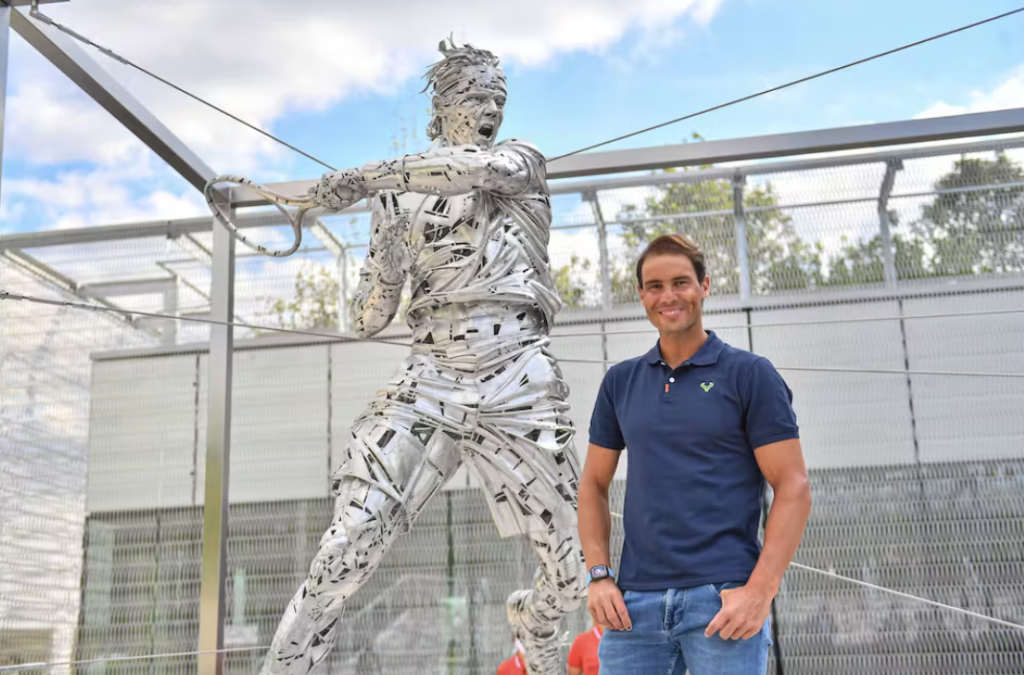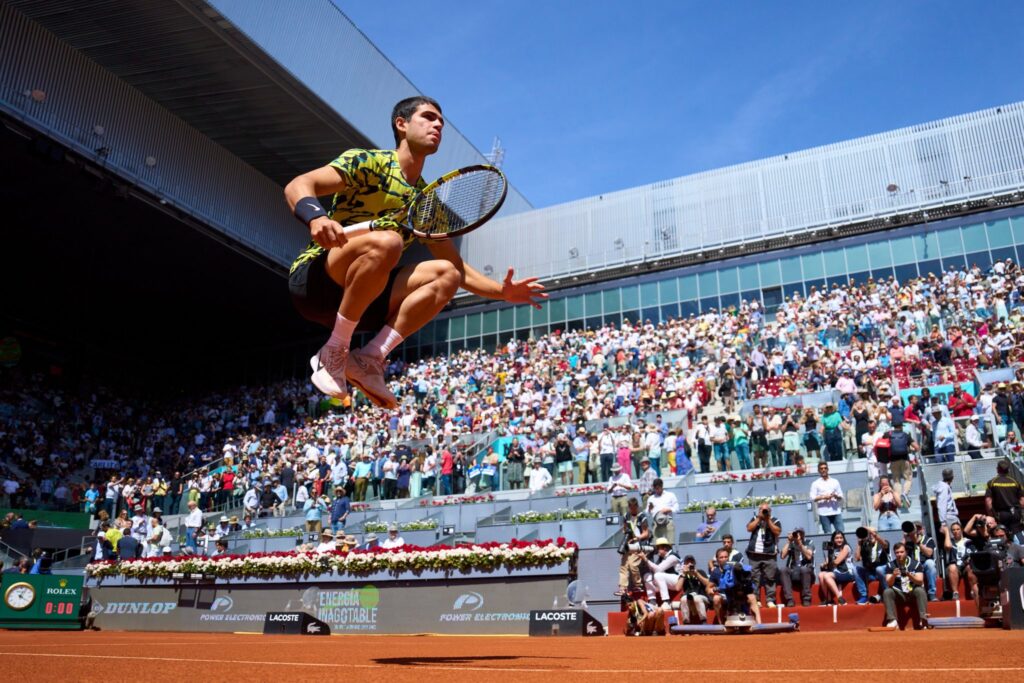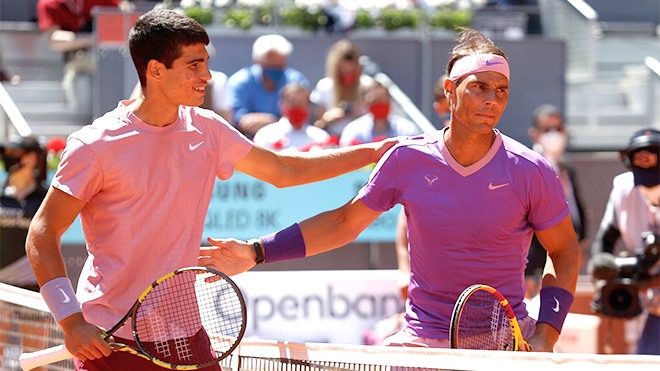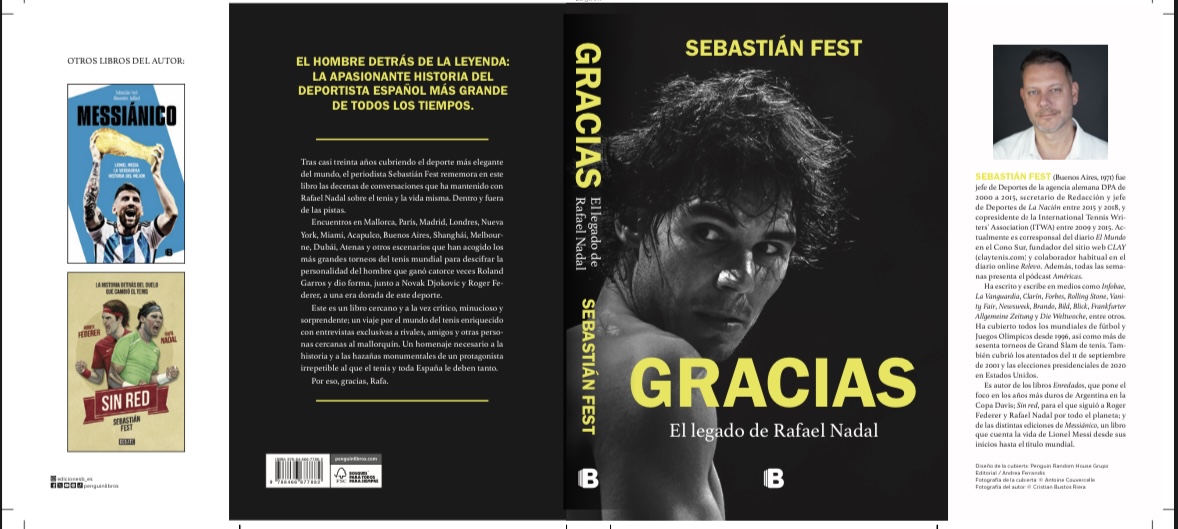This is an exclusive preview in English of “Gracias, Rafael Nadal’s legacy”, the book written by Sebastián Fest (Penguin Random House), which goes on sale this Thursday, November 23rd in Spain. Below is the complete first chapter of the book.
—————————————————————————————————————————————————
Paris, June 4, 2023. Sunday night, Carlos Alcaraz dines with his closest circle. Family, coaching staff and little else.
His Roland Garros’ run was going spectacularly, but the rest of the table looked at him strangely: the Spaniard was not happy.
“What I said was not what I meant,” he argued.
What was Alcaraz talking about, what hadn’t this twenty-year-old prodigy who arrived in Paris as world no.1 and with the aura of favorite? How could he be uneasy, if life was smiling on him?
That edition of the French Open was special because Rafael Nadal was missing. The fourteen-time champion of the tournament had announced weeks before, during a press conference in Manacor, that he was putting a “period” in his career. He would devote himself to conditioning his body. He wanted to concentrate on fixing what needed to be fixed – what could be fixed, if it could be fixed at all – in that armour that was his greatest ally and, at the same time, the great traitor.
Toni Nadal, his uncle and coach from childhood until 2016, explains it: since he started competing at the highest level, in 2003, until the end of 2023, Nadal missed sixteen Grand Slam tournaments due to injuries. In twenty-one years he spent five without playing. And yet he is still competing for the title of most successful player of all time.
[ CLAY is read for free. But if you can, please make a contribution here so we can keep telling you great #TennisStories around the world. It’s very easy and quick – thanks! ]
Tennis had been wondering for years about what would come after the “Big Three”, the Federer-Nadal-Djokovic trilogy. The three of them shaped a unique, unrepeatable era in tennis, but as it usually happens, when something lasts a long time, no matter if it is sublime, many ask themselves: “What now, who comes next?
The answer was clear in that June 2023: now Alcaraz, the next one is Alcaraz, US Open 2022 men’s singles champion at the age of nineteen and winner of Wimbledon in 2023 at 20. The youngest world number one in history since the ATP began to publish in 1973 its world ranking. The first teenager in history to close a season at the top.
Of Nadal, at that Roland Garros, the memory remained, his statue next to the stadium and an uncomfortable, almost anguishing question: what if he never came back, what if it was all over?
In that context of effervescence for the new kid on the block and the anticipated nostalgia at the possibility that Paris would never see its overwhelming champion again, the symbolic succession from Nadal to Alcaraz accelerated.

A French journalist asked Alcaraz, in Spanish, if he believed that Nadal’s fans, orphaned in that 2023 in Paris, now supported him. And Alcaraz, a fearless young guy, replied that yes, he was confident that those fans were now on his side.
The simple question had given way to a complicated answer. Was Alcaraz setting himself up as the successor to a player who had not yet retired, as the new power in place of the best sportsman in the history of Spain?
Of course not, but instead of answering that this could not be said, since no one will ever match what Nadal did in Paris and that his plan was to return to compete and win, Alcaraz answered that yes, he expected this transfusion of fans.
That’s why Alcaraz was worried that Sunday, a starry spring night in Paris.
“He didn’t mean in any way that he would take Nadal’s fans with him. But he messed up in response, he realized right away,” explained a member of his entourage.
That Nadal’s name came up in almost every contact Alcaraz had with the press was only natural. The story was too good, almost unreal. Eighteen years after Nadal’s explosive emergence in the 2005 season, another Spaniard, also dark-haired, also mind-blowingly intense and talented, was shaking up tennis. How not to compare them?
There was also a consensus in the world of the sport: Alcaraz included in his game a distillate of the best of Nadal, Federer and Djokovic. Many said it, among them Juan Carlos Ferrero, Alcaraz’s coach, in an interview with CLAY: “At a competitive level, Carlos is very good, on a stroke level he has that aggression of Djokovic, that approach to the net of Roger and mentally, obviously, Rafa. If you want to compare them with the three, I would go that way”.
Alcaraz sees it a little differently. In those days in Paris 2023, the author of this book asked him the question, “Many people see Nadal, Federer and Djokovic shots in your game, do you agree?”
The question was flawed, it was not about strokes, but about imprint, attitudes and qualities: what Ferrero said, competitiveness, offensive aggressiveness, mental strength. And Alcaraz, who at twenty years old had all the ambition in the world and was not at all interested in hiding it, answered logically:
“They say I have Nadal, Federer and Djokovic shots, because that’s what people have been used to seeing for 20 years. But I do not define myself, I have not tried to be like anyone else. I like to think that I’m 100 per cent me, and not a copy of any other player’s strokes.”
Alcaraz is right, he is nobody’s copy. And that is as true as “people have been used to see for twenty years” Nadal, Federer and Djokovic. People… and him.
Before Nadal burst into the tennis limelight, no player – at least not an elite player – jumped like a madman in the tunnel leading to the courts or at the net in front of his opponent at the time of the coin toss. The photos from Roland Garros 2023 show Alcaraz doing exactly what Nadal did throughout his career: jumping up and down, letting off steam in front of his opponents, giving them a good dose of intimidation in the process.

Alcaraz does that because Nadal did it. He grew up watching it on TV and took it for granted.
Alcaraz would not be the way he is if Nadal had not existed. Toni Nadal explains it very well.
– If there had been no Nadal, would an Alcaraz have been possible in Spain?
– Yes, of course, because a player like him is born by spontaneous generation. And everything, obviously, always follows a chain. In the end, what do you do in life? Alcaraz hits harder than Rafael. And Rafael hit harder than Bruguera. They both played with spin, Rafael did the same, but harder. You always start from where the other has arrived. When we arrived on tour and wanted to win on clay, we had to beat Coria, Ferrero and Moya. It is a law of life, always the one who arrives later has to overcome. Whoever wants to beat Usain Bolt knows that he has to run 9.50, and that anything else will not be enough.
– What is there of Nadal, Federer and Djokovic in Alcaraz’s game?
– I think Alcaraz is more like Rafael than Djokovic, who plays with less intensity than Rafael. Alcaraz plays with high intensity. Djokovic plays with great tranquility, without dismounting, like Murray.
– And what do you see from Federer?
– Maybe his offensive ambition. Alcaraz is very fast and has the ability to finish the point quickly. I think Federer hit much more elegantly, Federer did it much more elegantly than anyone else.
Antonio Martínez Cascales, the man who took Ferrero to number one and who acts as Alcaraz’s “coach’s coach”, whom he accompanies around the world in some tournaments, sees things in a very similar way to Toni Nadal.
“Carlos above all has ways of playing, more than strokes, of Nadal, Federer and Djokovic. Nadal’s tenacity, Federer’s quick transition and talented strokes, Djokovic’s elasticity.”
And, yes, it is true that in the young Alcaraz there are traces of the young Nadal. “It is true that one sees and copies the best. It is true that he jumps in the tunnel and at the net the way Nadal jumped, something that nobody did”.
There is, however, something in which the king and the prince, the consecrated and his successor, are very different. Nadal displayed throughout his career a modesty sometimes bordering on exasperation. A modesty that rested on what Uncle Toni’s Prussian education had engraved in his mind: respect, you always have to respect the other. To feel like a winner before the time is, in the Nadal’s eyes, a lack of respect for the rival. And setting exaggerated goals in public as well. Even if one is intimately convinced that they can be achieved.
That was the “Nadal method”. The “Alcaraz method” is radically different.

In December 2020, Alcaraz was number 141 in the world ranking and, in an interview with Cadena SER, he talked about his next steps in tennis: to be number one in the world.
Two years later, that bet was already insufficient. “I have been lucky to achieve my dreams very early, to be number one in the world, to win a Grand Slam.”
At that point it was already clear that Alcaraz does not dream, that Alcaraz does not “like” anything, Alcaraz does not offer any room for doubt: he proposes and arranges it, and he announces it beforehand, almost always with that smile from ear to ear that he generously shows in press conferences and in many moments of matches. Did Nadal smile on the courts? Very little. He always had a furrowed brow and competitive tension. If Nadal was activated from the armor, Alcaraz did it from the smile.
What did Alcaraz aspire to two years after setting and achieving goals unattainable for almost any mortal? “Right now my dream in tennis is to be one of the best in history, as I have repeated many times. It is possible that I am too ambitious, too big, but in this world you have to always dream big, always think big, set high-end goals.” Absolutely unthinkable in Nadal. Talking about “dreaming big” and “high-end goals” is as far from him as the possibility of joining the Communist Party.
Nadal, in his first Roland Garros, back in 2005, took the title. He was nineteen years old. Alcaraz, in his first Roland Garros, that of 2021, at the age of eighteen, lost in the third round.
He also did not win it in 2022, nor in 2023.
There are similarities, of course. And many differences.
Because Alcaraz is Alcaraz. And Nadal is Nadal.









